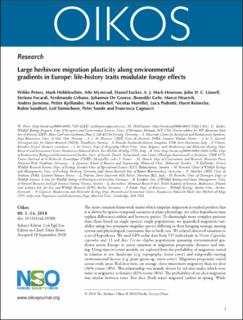| dc.contributor.author | Peters, Wibke | |
| dc.contributor.author | Hebblewhite, Mark | |
| dc.contributor.author | Mysterud, Atle | |
| dc.contributor.author | Eacker, Daniel | |
| dc.contributor.author | Hewison, A.J. Mark | |
| dc.contributor.author | Linnell, John Durrus | |
| dc.contributor.author | Focardi, Stefano | |
| dc.contributor.author | Urbano, Ferdinando | |
| dc.contributor.author | De Groeve, Johannes | |
| dc.contributor.author | Gehr, Benedikt | |
| dc.contributor.author | Heurich, Marco | |
| dc.contributor.author | Jarnemo, Anders | |
| dc.contributor.author | Kjellander, Petter | |
| dc.contributor.author | Kröschel, Max | |
| dc.contributor.author | Morellet, Nicolas | |
| dc.contributor.author | Pedrotti, Luca | |
| dc.contributor.author | Reinecke, Horst | |
| dc.contributor.author | Sandfort, Robin | |
| dc.contributor.author | Sönnichsen, Leif | |
| dc.contributor.author | Sunde, Peter | |
| dc.contributor.author | Cagnacci, Francesca | |
| dc.date.accessioned | 2023-05-22T12:12:31Z | |
| dc.date.available | 2023-05-22T12:12:31Z | |
| dc.date.created | 2018-12-25T13:02:25Z | |
| dc.date.issued | 2018 | |
| dc.identifier.citation | Oikos. 2018, 1-14. | en_US |
| dc.identifier.issn | 0030-1299 | |
| dc.identifier.uri | https://hdl.handle.net/11250/3068527 | |
| dc.description.abstract | The most common framework under which ungulate migration is studied predicts that it is driven by spatio–temporal variation in plant phenology, yet other hypotheses may explain differences within and between species. To disentangle more complex patterns than those based on single species/ single populations, we quantified migration vari-ability using two sympatric ungulate species differing in their foraging strategy, mating system and physiological constraints due to body size. We related observed variation to a set of hypotheses. We used GPS-collar data from 537 individuals in 10 roe Capreolus capreolus and 12 red deer Cervus elaphus populations spanning environmental gra-dients across Europe to assess variation in migration propensity, distance and tim-ing. Using time-to-event models, we explored how the probability of migration varied in relation to sex, landscape (e.g. topography, forest cover) and temporally-varying environmental factors (e.g. plant green-up, snow cover). Migration propensity varied across study areas. Red deer were, on average, three times more migratory than roe deer (56% versus 18%). This relationship was mainly driven by red deer males which were twice as migratory as females (82% versus 38%). The probability of roe deer migration was similar between sexes. Roe deer (both sexes) migrated earliest in spring. While territorial male roe deer migrated last in autumn, male and female red deer migrated around the same time in autumn, likely due to their polygynous mating system. Plant productivity determined the onset of spring migration in both species, but if plant productivity on winter ranges was sufficiently high, roe deer were less likely to leave. In autumn, migration coincided with reduced plant productivity for both species. This relationship was stronger for red deer. Our results confirm that ungulate migration is influenced by plant phenology, but in a novel way, that these effects appear to be modulated by species-specific traits, especially mating strategies. | en_US |
| dc.language.iso | eng | en_US |
| dc.rights | Navngivelse 4.0 Internasjonal | * |
| dc.rights.uri | http://creativecommons.org/licenses/by/4.0/deed.no | * |
| dc.subject | behavioral plasticity | en_US |
| dc.subject | forage maturation hypothesis | en_US |
| dc.subject | partial migration | en_US |
| dc.title | Large herbivore migration plasticity along environmental gradients in Europe: life-history traits modulate forage effects | en_US |
| dc.type | Peer reviewed | en_US |
| dc.type | Journal article | en_US |
| dc.description.version | publishedVersion | en_US |
| dc.rights.holder | © 2018 The Authors | en_US |
| dc.subject.nsi | VDP::Matematikk og Naturvitenskap: 400::Zoologiske og botaniske fag: 480 | en_US |
| dc.source.pagenumber | 297-455 | en_US |
| dc.source.volume | 128 | en_US |
| dc.source.journal | Oikos | en_US |
| dc.source.issue | 3 | en_US |
| dc.identifier.doi | 10.1111/oik.05588 | |
| dc.identifier.cristin | 1647095 | |
| dc.relation.project | Norges forskningsråd: 251112 | en_US |
| dc.relation.project | Norges forskningsråd: 212919 | en_US |
| dc.relation.project | Andre: Norwegian Environment Agency | en_US |
| dc.relation.project | Andre: Buskeud County | en_US |
| dc.relation.project | Andre: Centre for Advanced Study Oslo, Norway | en_US |
| cristin.unitcode | 7511,2,0,0 | |
| cristin.unitname | Avdeling for terrestrisk økologi | |
| cristin.ispublished | true | |
| cristin.fulltext | original | |
| cristin.qualitycode | 1 | |

